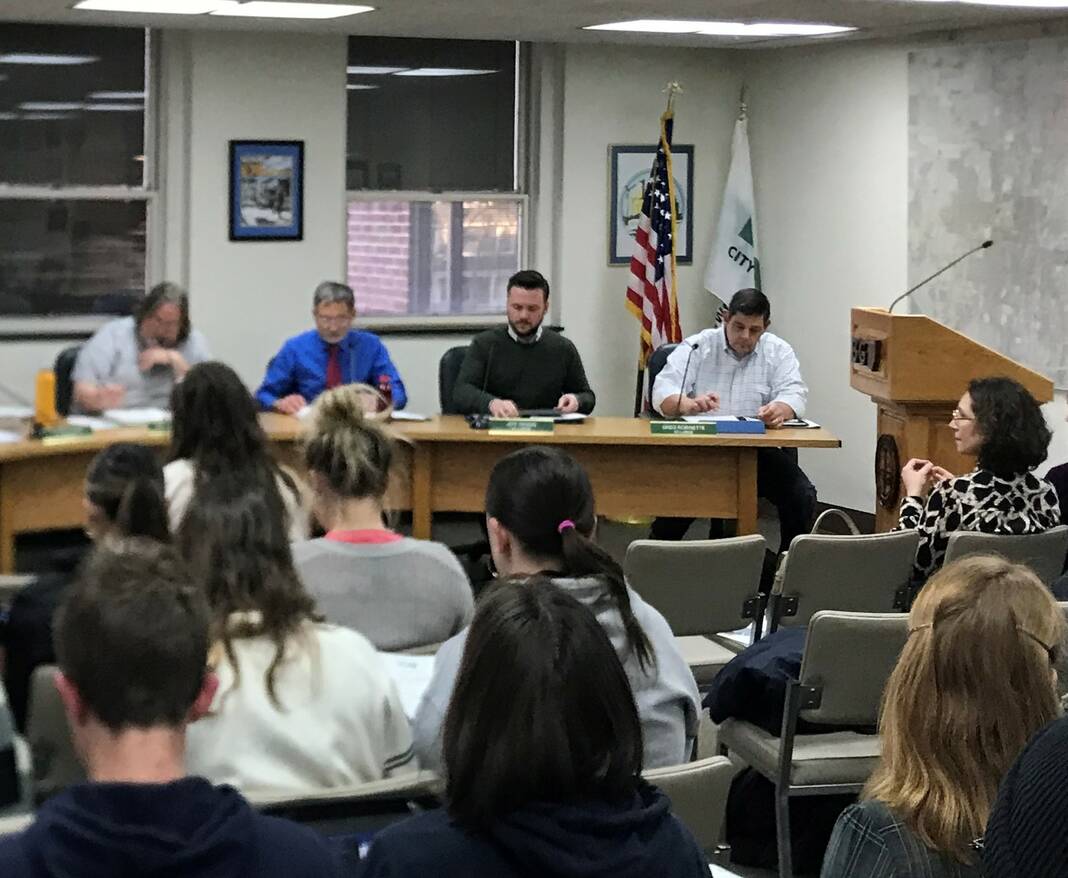
Bowling Green City Council members, from left, Mark Hollenbaugh, Bill Herald, Jeff Dennis and Greg Robinette.
Bowling Green City Council on Monday again heard from a number of residents about the proposed zoning code update, just days in advance of a public forum scheduled on the topic.
“We, the members of the Save Our BG Neighborhoods Committee, are looking forward to the public forum on Thursday,” said resident Marilyn Shrude.
The forum is to take place at 6 p.m. that day at the Veterans Building in City Park.
“We view this as an opportunity for open dialogue, a chance to ask our questions and to receive your answers. And you probably have some questions for us as well,” Shrude said.
She noted that council has heard speakers’ concerns in recent months “but we still aren’t sure what you’re thinking. We have to believe we are all on the same side” and all want to make the city a place that residents can be proud of.
She said that they want to work with council in a spirit of collaboration.
Some of the comments made Monday evening addressed elements of the controversial Pedestrian Residential District, a portion of the proposed zoning code update which far and away has received the most comment from residents.
Referred to frequently as the “PR,” it is a neighborhood area located in a rough, elongated donut around the downtown. The proposed area is bordered by Poe Road to the north, Napoleon Road to the south, and on the east largely by Enterprise Street. To the west, it is substantially bordered by Maple Street, but it also extends to include portions along Eberly and Gorrell avenues.
Among the Pedestrian Residential district’s major features is that it would allow some businesses to operate within that neighborhood district, and alter minimum lot dimensions.
“We are definitely supporters of our downtown businesses, but we do not want to have a business right next door,” said Jeanine Alberti. “That is not what we signed up for 35 years ago when we bought our home in a residential neighborhood.…
“We paid our dues when we were younger. We rented different homes that we lived in at times,” Alberti continued. “However, we are concerned with the possibility of multi-family dwellings” and the reduction of lost sizes, proposed in the PR, creating population density in the neighborhood.
Among the issues discussed Monday by Rose Hess was a concern about non-conforming rentals.
“I have seen the change on the East Side, where I live,” she said. “Non-conforming rentals, no matter how good this code is … if you don’t tackle non-conforming properties, this decay is only going to get worse.”
She said that, in total, 260 such properties have been counted in the city.
Picking up on that point, Joyce Kepke noted that the citizen-suggested Central Residential District proposal, which would replace the PR, would not permit new duplexes to be built. She said that the non-conforming properties in question are homes originally designed for single families that were later divided up into rentals. She said that 77% of them are located in the proposed PR.
“This PR district already has its fair share of duplexes and non-conforming dwellings, and I believe we’re reaching the tipping point,” Kepke said.
She said that, under the PR, that area would change from a diverse mix of uses to largely duplexes and rentals with some businesses mixed in.
People looking for less-expensive single family homes wouldn’t be able to find them, Kepke said.
“Buyers looking for homes have told you that less expensive homes are snatched up by rental companies before they can even put in a bid,” she said. “Are we not concerned about what kind of community we will be when the current rental rate of 65% continues to increase?”
“It’s the renters we want to protect,” Sandy Wicks said. “We want to talk to the rental owners and make sure they understand they need to keep the properties up and maintained so that the people renting the homes do not live in substandard homes.”
Wicks then turned to the issue of preserving the downtown. She said that the area of the proposed PR “is the most walkable zone in the city of Bowling Green” according to a national study “and I think it is important for us to maintain that rating by encouraging the downtown businesses.”
Wicks said that, walking from Clay Street to Lehman Avenue, and one block further east and west, “at this current time, there are 14 empty storefronts. And talking to some of the business owners downtown, there are at least 30 empty office spaces, with the Huntington Bank building having 20 alone. I think we have a lot to do in this city, and I agree, there are many changes to the code that could be beneficial to the city. But this one I think is misplaced. What we need to focus on is maintaining the neighborhoods and supporting the downtown and encouraging young people and business owners to come and open their businesses downtown. That’s who we are. Our city exists because of many things, but a vibrant downtown is definitely one of them.”
At the end of Monday’s meeting, council President Mark Hollenbaugh previewed Thursday’s public forum. He noted that it will be an opportunity for community members to speak with council members and let them know the things they like, and don’t like, about the proposed zoning code update.
He said the meeting will begin with three 5-to-7 minute presentations, each focused respectively on the PR, the Central Residential District, and a zoning plan proposed by council members Rachel Phipps and Jeff Dennis during council’s recent work session on March 13. Then small-group roundtable discussions will follow, with citizens able to come up with questions they would like to have an answer to.
The forum will proceed from there, Hollenbaugh said.

